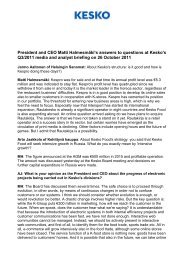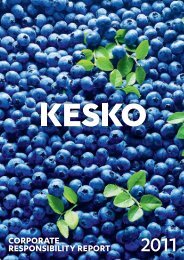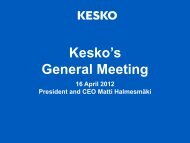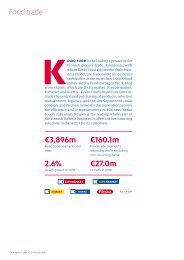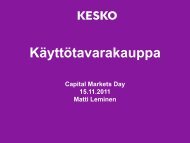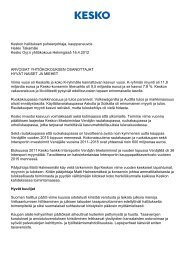Kesko's Annual Report 2009
Kesko's Annual Report 2009
Kesko's Annual Report 2009
Create successful ePaper yourself
Turn your PDF publications into a flip-book with our unique Google optimized e-Paper software.
Kesko financial statements <strong>2009</strong><br />
Notes to the parent's financial statements<br />
Principles used for preparing the parent's<br />
financial statements<br />
Kesko Corporation's financial statements have been prepared in<br />
compliance with the Finnish Accounting Standards (FAS).<br />
Non-current assets<br />
Intangible assets<br />
Intangible assets are stated in the balance sheet at cost less<br />
depreciation according to plan.<br />
Depreciation plan<br />
Other capitalised expenditure 5–14 years<br />
Tangible assets<br />
Tangible assets are stated in the balance sheet at cost less depreciation<br />
according to plan.<br />
Depreciation plan<br />
Depreciation according to plan is calculated on a straight line<br />
basis so as to write off the cost of tangible assets over their estimated<br />
useful lives.<br />
The periods adopted for depreciation are as follows:<br />
Buildings 15–33 years<br />
Fixtures and fittings 8 years<br />
Machinery and equipment 8 years<br />
or machinery and equipment<br />
purchased since 1999 25% reducing balance method<br />
Transportation fleet 5 years<br />
Information technology equipment 3–5 years<br />
Other tangible assets 5–14 years<br />
Land has not been depreciated. The total of depreciation according<br />
to plan and the change in depreciation reserve comply with<br />
the Finnish tax legislation. The change in depreciation reserve<br />
has been treated as appropriations in the parent company.<br />
Valuation of financial assets<br />
Marketable securities have been valued at lower of cost or net<br />
realisable value.<br />
Foreign currencies<br />
Items denominated in foreign currencies have been translated<br />
into Finnish currency at the average exchange rate of the European<br />
Central Bank at the balance sheet date. If a receivable or a<br />
debt is tied to a fixed rate of exchange, it has been used for<br />
translation. Exchange rate differences have been recognised in<br />
profit or loss.<br />
Derivative financial instruments<br />
Interest rate derivative contracts<br />
Interest rate derivatives are used to modify loan durations. The<br />
target duration is three years and it is allowed to vary between<br />
one and a half and four years. Cash flows arising from interest<br />
rate derivative contracts are recognised during the financial year<br />
as interest income or expenses, according to the maturity date.<br />
In the financial statements, open forward agreements, futures,<br />
options and swaps are stated at market values. Unrealised<br />
revaluation is not stated as income. Any valuation losses are<br />
included in interest expenses.<br />
139<br />
Currency derivative contracts<br />
Currency derivative instruments are used for hedging against<br />
translation and transaction risks. Forward exchange contracts are<br />
valued at the exchange rate of the balance sheet date. The rate<br />
differences arising from open derivative contracts are reported in<br />
financial items. If a derivative instrument has been used to<br />
hedge a foreign-currency-denominated asset, the value change<br />
has been recognised against that of the asset item. The premiums<br />
of option contracts are included in the balance sheet accruals<br />
until they expire, or if a value change at the balance sheet<br />
date so requires, recognition in profit or loss.<br />
Commodity derivatives<br />
Kestra Kiinteistöpalvelut Oy, a Kesko Corporation subsidiary, uses<br />
electricity derivatives to balance the energy costs of the Group<br />
and its retailers. <strong>Kesko's</strong> subsidiaries engaged in the agricultural<br />
trade use grain derivatives to hedge against the grain price risk.<br />
Kesko Corporation is an external counterparty in electricity and<br />
grain derivative contracts made with the bank, and internally<br />
hedges the corresponding price with the subsidiary. At no stage<br />
does Kesko Corporation have derivative positions, and thus there<br />
are no effects on profit or loss. The electricity price risk is<br />
reviewed on a 3-year time span. With respect to derivative contracts<br />
hedging the price of electricity supplied during the financial<br />
year, changes in value are recognised in Kesko under interest<br />
income and expenses. The unrealised gains and losses of contracts<br />
hedging future purchases are not recognised through profit<br />
or loss. With respect to grain derivative contracts, the open contracts<br />
in the income statement are recognised at market prices.<br />
Valuation differences related to open contracts are recognised in<br />
Kesko under financial items.<br />
Pension plans<br />
The pension insurances of Kesko Corporation's personnel are<br />
arranged through the Kesko Pension Fund. The Fund's A department,<br />
which provides supplementary pension benefits, was<br />
closed on 9 May 1998. The job-based retirement age agreed for<br />
some of the personnel is 60 or 62 years. Pensions are expensed<br />
in the income statement.<br />
Provisions<br />
Provisions stated in the balance sheet include items bound to by<br />
agreements or otherwise, but remain unrealised. Changes in provisions<br />
are included in the income statement. Rent liabilities for<br />
vacant rented premises no longer used for the Group business<br />
operations, as well as the losses resulting from renting the<br />
premises to outsiders, are included in provisions.<br />
Income tax<br />
Income tax includes the income tax payments for the period<br />
based on the profit for the period, and taxes payable for prior<br />
periods, or tax refunds. Deferred taxes are not included in the<br />
parent's income statement and balance sheet.




